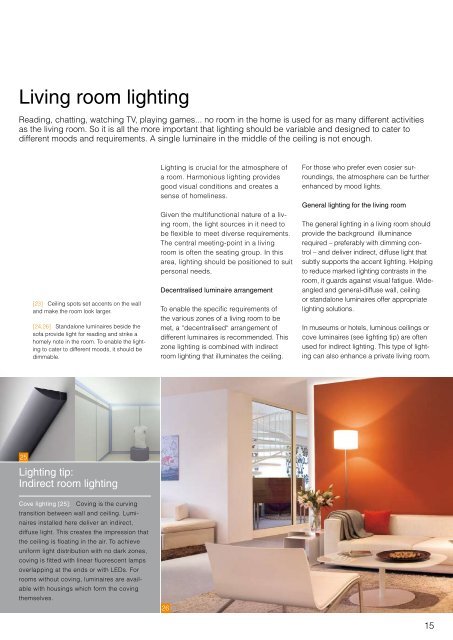licht.wissen No. 14 "Ideas for Good Home Lighting"
One of the most important things in life is having a place where we really feel at home. Booklet No. 14 gives some ideas for good lighting at home. Packed with illustrative photographs, it shows how living room, bathroom, kitchen, home office and terrace lighting can strike an inviting note. Free Download at www.licht.de/en
One of the most important things in life is having a place where we really feel at home. Booklet No. 14 gives some ideas for good lighting at home. Packed with illustrative photographs, it shows how living room, bathroom, kitchen, home office and terrace lighting can strike an inviting note. Free Download at www.licht.de/en
You also want an ePaper? Increase the reach of your titles
YUMPU automatically turns print PDFs into web optimized ePapers that Google loves.
Living room lighting<br />
Reading, chatting, watching TV, playing games... no room in the home is used <strong>for</strong> as many different activities<br />
as the living room. So it is all the more important that lighting should be variable and designed to cater to<br />
different moods and requirements. A single luminaire in the middle of the ceiling is not enough.<br />
[23] Ceiling spots set accents on the wall<br />
and make the room look larger.<br />
[24,26] Standalone luminaires beside the<br />
sofa provide light <strong>for</strong> reading and strike a<br />
homely note in the room. To enable the lighting<br />
to cater to different moods, it should be<br />
dimmable.<br />
Lighting is crucial <strong>for</strong> the atmosphere of<br />
a room. Harmonious lighting provides<br />
good visual conditions and creates a<br />
sense of homeliness.<br />
Given the multifunctional nature of a living<br />
room, the light sources in it need to<br />
be flexible to meet diverse requirements.<br />
The central meeting-point in a living<br />
room is often the seating group. In this<br />
area, lighting should be positioned to suit<br />
personal needs.<br />
Decentralised luminaire arrangement<br />
To enable the specific requirements of<br />
the various zones of a living room to be<br />
met, a “decentralised“ arrangement of<br />
different luminaires is recommended. This<br />
zone lighting is combined with indirect<br />
room lighting that illuminates the ceiling.<br />
For those who prefer even cosier surroundings,<br />
the atmosphere can be further<br />
enhanced by mood lights.<br />
General lighting <strong>for</strong> the living room<br />
The general lighting in a living room should<br />
provide the background illuminance<br />
required – preferably with dimming control<br />
– and deliver indirect, diffuse light that<br />
subtly supports the accent lighting. Helping<br />
to reduce marked lighting contrasts in the<br />
room, it guards against visual fatigue. Wideangled<br />
and general-diffuse wall, ceiling<br />
or standalone luminaires offer appropriate<br />
lighting solutions.<br />
In museums or hotels, luminous ceilings or<br />
cove luminaires (see lighting tip) are often<br />
used <strong>for</strong> indirect lighting. This type of lighting<br />
can also enhance a private living room.<br />
25<br />
Lighting tip:<br />
Indirect room lighting<br />
Cove lighting [25]: Coving is the curving<br />
transition between wall and ceiling. Luminaires<br />
installed here deliver an indirect,<br />
diffuse light. This creates the impression that<br />
the ceiling is floating in the air. To achieve<br />
uni<strong>for</strong>m light distribution with no dark zones,<br />
coving is fitted with linear fluorescent lamps<br />
overlapping at the ends or with LEDs. For<br />
rooms without coving, luminaires are available<br />
with housings which <strong>for</strong>m the coving<br />
themselves.<br />
26<br />
15

















